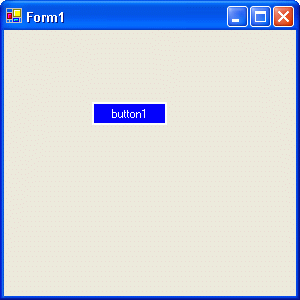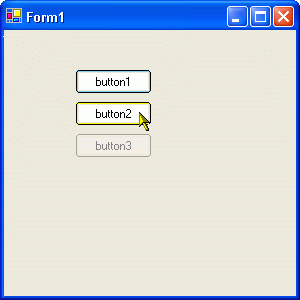如何重画Windows控件
http://www.uncj.net/bbs/index.asp 2003-1-17 ;程序员大联盟
概述
当你在全新体验Windows XP令人赏心悦目的界面的时候,你一定在想"如果我的程序界面也都能这么漂亮,那该多好啊"。那就让我们来看看到底应该如何通过.NET类库来重画Windows标准控件。
本文通过两个例子来阐述如何通过程序编码来有效的改变Windows标准控件外观。
平台需求
Visual Studio .NET
Visual C# .NET
例1:改变控件属性
使用Visual Studio .NET来开发软件时,可以利用其强大的IDE环境来手工设定界面控件的属性。但是如果你要使你整个程序上的控件风格都是某种特定属性的话,那最好的方法就是自己重载控件类。
让我们从最简单的System.Windows.Forms.Button类开始尝试,按钮有如下的常用属性:
BackColor--按钮的背景颜色
Cursor--鼠标状态
Enabled--是否启用按钮
FlatStyle--按钮的扁平风格
Font--按钮上的字体
ForeColor--按钮的前景颜色
Height--按钮的高度
Image--按钮上的图片
Location--按钮上的位置
Text--按钮上的文字
Visible--按钮是否可见
Width--按钮的宽度
在下面的这个例子里面,我们得到一个蓝底白字的扁平按钮:
1、在Visual C# .NET中新建一个Windows Application项目,命名为OwnDrawButton1;
2、往项目中添加一个MyButton类,将其改为继承System.Windows.Forms.Button,并在构造函数中添加修改属性的代码;
就像这样:
public class MyButton : System.Windows.Forms.Button
{
public MyButton()
{
//set the back color to blue
BackColor = System.Drawing.Color.Blue;
//set the appearance style to flat
FlatStyle = System.Windows.Forms.FlatStyle.Flat;
//use system default font
Font = System.Windows.Forms.Control.DefaultFont;
//use white color to write text and draw the border
ForeColor = System.Drawing.Color.White;
}
}
3、拖一个按钮到Form1上,右击鼠标,单击"View Code",在代码中用"MyButton"替换掉"System.Windows.Forms.Button";
4、编译执行。
现在,你就能在你的界面上看到自定义的控件了(如图1)。

图1 通过代码修改控件属性的按钮
例2:重画简单控件
仅通过改变控件的属性值来自定义控件,在很多情况下是不能令人满意的。例如如果想把Windows XP里那种风格的按钮放到Windows 98/2000下,你就得自己来画那些按钮了。
在这种情况下,你可以通过重载OnPaint()等事件来重画按钮。你也可以通过EventHandler来让控件响应更多的事件,例如,我们可以给按钮添加鼠标悬停效果,给MouseEnter和MouseLeave分别加上EeventHandler,这样,你在事件响应函数里写的代码就会被调用。
下面是一个例子,这个例子编写了一个类似Windows XP中按钮风格的控件:
1、在Visual C# .NET中新建一个Windows Application项目,命名为OwnDrawButton2;
2、往项目中添加一个MyButton类,将其改为继承System.Windows.Forms.Button,在构造函数中添加修改属性的代码和事件响应关联代码,并编写各函数代码,如下所列:
using System;
using System.Drawing;
using System.Windows;
using System.Windows.Forms;
namespace OwnDrawButton2
{
public class MyButton : System.Windows.Forms.Button
{
//state variable for mouse down
private bool mouseDown = false;
//state variable for mouse hover
private bool mouseHover = false;
public MyButton()
{
//set the control UserPaint
SetStyle(ControlStyles.UserPaint, true);
//EventHandler for MouseDown
MouseDown += new MouseEventHandler(OnMouseDown);
//EventHandler for MouseUp
MouseUp += new MouseEventHandler(OnMouseUp);
//EventHandler for MouseEnter
MouseEnter += new EventHandler(OnMouseEnter);
//EventHandler for MouseLeave
MouseLeave += new EventHandler(OnMouseLeave);
Height = 23;//Default Height
Width = 75;//Default Width
}
protected override void OnPaint(PaintEventArgs pe)
{
//first, paint the control with parent form's background color
pe.Graphics.FillRectangle(new SolidBrush(Parent.BackColor),
pe.ClipRectangle);
//if the button is disabled, draw the disable style
if (Enabled == false)
{
DrawDisableButton(pe.Graphics);
}
else if (mouseDown)
{
//when mouse down, draw the mouse down style
DrawMouseDownButton(pe.Graphics);
}
else if (mouseHover)
{
//when mouse hover, draw the mouse hover style
DrawMouseHoverButton(pe.Graphics);
}
else if (Focused)
{
//when mouse is focused but not mouse hover,
//draw the focus style
DrawContainFocusButton(pe.Graphics);
}
else//else, draw the normal style
{
DrawNormalButton(pe.Graphics);
}
WriteText(pe.Graphics);//write text
}
private void OnMouseDown(object sender, MouseEventArgs e)
{
mouseDown = true; //mouse is down now
}
private void OnMouseUp(object sender, MouseEventArgs e)
{
mouseDown = false; //mouse is up now
//call paint action
PaintEventArgs pe =
new PaintEventArgs(CreateGraphics(), ClientRectangle);
OnPaint(pe);
}
private void OnMouseEnter(object sender, EventArgs e)
{
mouseHover = true; //mouse hover on
//call paint action
PaintEventArgs pe =
new PaintEventArgs(CreateGraphics(), ClientRectangle);
OnPaint(pe);
}
private void OnMouseLeave(object sender, EventArgs e)
{
mouseHover = false; //mouse is not hover on
//call paint action
PaintEventArgs pe =
new PaintEventArgs(CreateGraphics(), ClientRectangle);
OnPaint(pe);
}
private void DrawBorder(Graphics g, int state)
{
if (state == 1)//draw normal style broder
{
Pen p = new Pen(SystemColors.ControlLightLight, 2);
g.DrawLine(p, 1, 1, 1, Height - 2);
g.DrawLine(p, 1, 1, Width - 2, 1);
g.DrawLine(p, Width - 1, 2, Width - 1, Height - 2);
g.DrawLine(p, 2, Height - 1, Width - 2, Height - 1);
}
else if (state == 2)//draw hover style border
{
Pen p = new Pen(Color.Yellow, 2);
g.DrawLine(p, 1, 1, 1, Height - 2);
g.DrawLine(p, 1, 1, Width - 2, 1);
g.DrawLine(p, Width - 1, 2, Width - 1, Height - 2);
g.DrawLine(p, 2, Height - 1, Width - 2, Height - 1);
}
else if (state == 3)//draw pressed style border
{
Pen p = new Pen(SystemColors.ControlDark, 2);
g.DrawLine(p, 1, 1, 1, Height - 2);
g.DrawLine(p, 1, 1, Width - 2, 1);
g.DrawLine(p, Width - 1, 2, Width - 1, Height - 2);
g.DrawLine(p, 2, Height - 1, Width - 2, Height - 1);
}
else if (state == 4)//draw disabled style border
{
Pen p = new Pen(SystemColors.ControlLight, 2);
g.DrawLine(p, 1, 1, 1, Height - 2);
g.DrawLine(p, 1, 1, Width - 2, 1);
g.DrawLine(p, Width - 1, 2, Width - 1, Height - 2);
g.DrawLine(p, 2, Height - 1, Width - 2, Height - 1);
}
else if (state == 5)//draw default style border
{
Pen p = new Pen(Color.SkyBlue, 2);
g.DrawLine(p, 1, 1, 1, Height - 2);
g.DrawLine(p, 1, 1, Width - 2, 1);
g.DrawLine(p, Width - 1, 2, Width - 1, Height - 2);
g.DrawLine(p, 2, Height - 1, Width - 2, Height - 1);
}
if (state == 4)//draw disable style border
{
Pen p = new Pen(Color.FromArgb(161, 161, 146), 1);
g.DrawLine(p, 0, 2, 0, Height - 3);
g.DrawLine(p, 2, 0, Width - 3, 0);
g.DrawLine(p, Width - 1, 2, Width - 1, Height - 3);
g.DrawLine(p, 2, Height - 1, Width - 3, Height - 1);
g.DrawLine(p, 0, 2, 2, 0);
g.DrawLine(p, 0, Height - 3, 2, Height - 1);
g.DrawLine(p, Width - 3, 0, Width - 1, 2);
g.DrawLine(p, Width - 3, Height - 1, Width - 1, Height - 3);
}
else//draw normal style border
{
g.DrawLine(Pens.Black, 0, 2, 0, Height - 3);
g.DrawLine(Pens.Black, 2, 0, Width - 3, 0);
g.DrawLine(Pens.Black, Width - 1, 2, Width - 1, Height - 3);
g.DrawLine(Pens.Black, 2, Height - 1, Width - 3, Height - 1);
g.DrawLine(Pens.Black, 0, 2, 2, 0);
g.DrawLine(Pens.Black, 0, Height - 3, 2, Height - 1);
g.DrawLine(Pens.Black, Width - 3, 0, Width - 1, 2);
g.DrawLine(Pens.Black, Width - 3, Height - 1,
Width - 1, Height - 3);
}
}
private void DrawNormalButton(Graphics g)//draw normal style button
{
//draw normal style border
DrawBorder(g, 1);
//paint background
PaintBack(g, SystemColors.ControlLightLight);
}
private void DrawMouseHoverButton(Graphics g)
{
//draw mouse hover style border
DrawBorder(g, 2);
//paint background
PaintBack(g, SystemColors.ControlLightLight);
}
private void DrawMouseDownButton(Graphics g)
{
//draw mouse down style border
DrawBorder(g, 3);
//paint background
PaintBack(g, SystemColors.ControlLight);
}
private void DrawDisableButton(Graphics g)
{
//draw disable style border
DrawBorder(g, 4);
//paint background
PaintBack(g, SystemColors.ControlLight);
}
private void DrawContainFocusButton(Graphics g)
{
//draw contain focuse style border
DrawBorder(g, 5);
//paint background
PaintBack(g, SystemColors.ControlLightLight);
}
//paint background area of the button
private void PaintBack(Graphics g, Color c)
{
g.FillRectangle(new SolidBrush(c), 3, 3,
Width - 6, Height - 6);
}
private void WriteText(Graphics g)
{
//calculate the text position
int x = 0, y = 0;
Size s = g.MeasureString(Text, Font).ToSize();
x = (Width - s.Width) / 2;
y = (Height - s.Height) / 2;
//draw text
if (Enabled) //is enabled, draw black text
g.DrawString(Text, Font, Brushes.Black, x, y);
else //not enabled, draw gray text
g.DrawString(Text, Font, Brushes.Gray, x, y);
}
}
}
3、在新控件的构造函数中添加:拖3个按钮到Form1上,将其中一个的"Enable"设为"false",右击鼠标,单击"View Code",在代码中用"MyButton"替换掉"System.Windows.Forms.Button";
4、编译执行。
最终,我们就得到了如图2所示的按钮控件。它可以在任何版本的windows操作系统上都保持一个样子。

图2 一个类似于Windows XP样式的按钮控件
原作者:痕迹
来 源:本站
共有561位读者阅读过此文